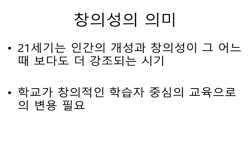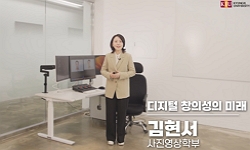This study was intended to analyze the `Life and Technology` unit in the practical course of the 2009 revised national curriculum and then developed and applied an invention education program applying the RSP (Reverse Science from Product) model and e...
http://chineseinput.net/에서 pinyin(병음)방식으로 중국어를 변환할 수 있습니다.
변환된 중국어를 복사하여 사용하시면 됩니다.
- 中文 을 입력하시려면 zhongwen을 입력하시고 space를누르시면됩니다.
- 北京 을 입력하시려면 beijing을 입력하시고 space를 누르시면 됩니다.

RSP 모형을 적용한 `생활과 기술` 단원 중심 발명교육 프로그램이 창의성에 미치는 효과 = An Effect of `Invention Education Program` Applying RSP Model in Elementary Practical Arts on Creativity -Focus on Unit of `Life and Technology`-
한글로보기https://www.riss.kr/link?id=A102655866
- 저자
- 발행기관
- 학술지명
- 권호사항
-
발행연도
2016
-
작성언어
-
- 주제어
-
KDC
300
-
등재정보
KCI등재
-
자료형태
학술저널
-
수록면
115-134(20쪽)
-
KCI 피인용횟수
3
- DOI식별코드
- 제공처
- 소장기관
-
0
상세조회 -
0
다운로드
부가정보
다국어 초록 (Multilingual Abstract)
This study was intended to analyze the `Life and Technology` unit in the practical course of the 2009 revised national curriculum and then developed and applied an invention education program applying the RSP (Reverse Science from Product) model and examined students` changes in creativity, satisfaction with the program, and its effects on invention learning. For the research, one fifth-grade class at Seoul D Elementary School was selected and the program was applied. To analyze the results, the researcher used the TTCT sheet and performed pre- and post single group comparison to see the changes of their creativity and also conducted a survey on their program satisfaction and its effects on invention learning. The results can be summed up as below: First, by analyzing the `Life and Technology` unit in the practical course of the 2009 revised curriculum, an invention education program with 12 sessions using an RSP model was developed. Second, after the invention education program was applied, students` creativity did improve. According to the results of TTCT sheet, among creativity factors, the fluency score changed from 19.14 to 24.68 (t=4.419, significant probability 0.000), the originality score changed from 7.56 to 10.50 (t=4.197, significant probability 0.000), and the elaboration score changed from 4.90 to 5.68 (t=2.854, significant probability 0.009); thus, all the three factors did increase significantly. Third, the program applying the RSP model influenced students` recognition on and attitude to invention positively. Over 90% of the students answered that they could understand the necessity and methods of invention after the invention education activities and came to think that invention was something familiar to them. Fourth, the program applying the RSP model was found to be effective for invention education. Students answered that this program did help them to produce invention ideas and it was easy to produce ideas thanks to the program and showed confidence about invention. According to the results of developing and applying the invention education program applying the RSP model, students` creativity was improved, and their recognition on and attitude to invention changed. From now on, it will be needed to keep providing them with invention education activities connected with subject education. Lastly, we suggest that it will be necessary to perform follow-up research about invention education programs applicable to various subjects by introducing the subject group system under the 2009 revised curriculum or strengthening convergent education to cultivate persons of ability.
참고문헌 (Reference)
1 신재경, "특성화고에서 RESP 교육모형을 적용한 발명교육 프로그램 개발 및 적용 방안" 2013
2 유경훈, "초중고 학생의 창의성 발달 특성 연구" 한국창의력교육학회 13 (13): 43-60, 2013
3 서우석, "초등학교 실과 5" 두산동아(주) 2014
4 이춘식, "초등학교 실과 5" ㈜천재교과서 2014
5 권혁수, "초등학교 실과 5" ㈜미래엔 2014
6 정성봉, "초등학교 실과 5" ㈜교학사 2014
7 송현순, "초등학교 실과 5" 비상교육 2014
8 이상원, "초등학교 실과 5" ㈜천재교육 2014
9 이충희, "초등학교 6학년 1학기 과학교과서 분석을 통한 발명교육 활동의 개발 및 적용" 서울교육대학교 교육대학원 2012
10 이미경, "초등학교 4학년 교과 수업과 연계한 발명교육의 교수·학습 전략 탐색" 서울교육대학교 교육대학원 2011
1 신재경, "특성화고에서 RESP 교육모형을 적용한 발명교육 프로그램 개발 및 적용 방안" 2013
2 유경훈, "초중고 학생의 창의성 발달 특성 연구" 한국창의력교육학회 13 (13): 43-60, 2013
3 서우석, "초등학교 실과 5" 두산동아(주) 2014
4 이춘식, "초등학교 실과 5" ㈜천재교과서 2014
5 권혁수, "초등학교 실과 5" ㈜미래엔 2014
6 정성봉, "초등학교 실과 5" ㈜교학사 2014
7 송현순, "초등학교 실과 5" 비상교육 2014
8 이상원, "초등학교 실과 5" ㈜천재교육 2014
9 이충희, "초등학교 6학년 1학기 과학교과서 분석을 통한 발명교육 활동의 개발 및 적용" 서울교육대학교 교육대학원 2012
10 이미경, "초등학교 4학년 교과 수업과 연계한 발명교육의 교수·학습 전략 탐색" 서울교육대학교 교육대학원 2011
11 주희정, "아이디어 발상기법을 활용한 실과 '옷입기와 관리하기' 단원의 발명교육활동 개발 및 적용" 서울교육대학교 교육대학원 2013
12 특허청, "발명교육 이론" 아이피티처 2007
13 송나래, "기술․가정 교과 ‘기술과 발명’ 단원에서 RESP 교육 모형 적용 발명 프로그램 개발" 충남대학교 대학원 2014
14 교육과학기술부, "2009 개정교육과정에 따른 실과 교육과정"
15 특허청, "2005 학생발명진흥사업 조사 결과 보고서" 특허청 2005
동일학술지(권/호) 다른 논문
-
- 서울교육대학교 초등교육연구원
- 김주연 ( Kim Joo Yon )
- 2016
- KCI등재
-
- 서울교육대학교 초등교육연구원
- 이재용 ( Lee Jae Yong )
- 2016
- KCI등재
-
과정극(Process Drama)을 활용한 6학년 영어 쓰기 수업에 관한 실행연구
- 서울교육대학교 초등교육연구원
- 박유라 ( Park Yu Ra )
- 2016
- KCI등재
-
음악의 종류와 분당비트수가 초등학생의 분당 심박수 및 신체활동량에 미치는 영향
- 서울교육대학교 초등교육연구원
- 엄우섭 ( Eom Woo Seob )
- 2016
- KCI등재
분석정보
인용정보 인용지수 설명보기
학술지 이력
| 연월일 | 이력구분 | 이력상세 | 등재구분 |
|---|---|---|---|
| 2022-03-08 | 학회명변경 | 영문명 : Elementary Education Research Center -> Elementary Education Research Institute |  |
| 2022 | 평가예정 | 재인증평가 신청대상 (재인증) | |
| 2019-01-01 | 평가 | 등재학술지 유지 (계속평가) |  |
| 2016-01-01 | 평가 | 등재학술지 선정 (계속평가) |  |
| 2015-01-01 | 평가 | 등재후보학술지 유지 (계속평가) |  |
| 2013-01-01 | 평가 | 등재후보학술지 유지 (기타) |  |
| 2012-01-01 | 평가 | 등재후보학술지 유지 (기타) |  |
| 2011-12-08 | 학술지명변경 | 외국어명 : 미등록 -> Korean Journal of Elementary Education |  |
| 2011-01-01 | 평가 | 등재후보 1차 PASS () |  |
| 2009-01-01 | 평가 | 등재후보학술지 선정 () |  |
| 2007-05-03 | 학회명변경 | 한글명 : 초등교육연구소 -> 초등교육연구원 |
학술지 인용정보
| 기준연도 | WOS-KCI 통합IF(2년) | KCIF(2년) | KCIF(3년) |
|---|---|---|---|
| 2016 | 0.96 | 0.96 | 1.03 |
| KCIF(4년) | KCIF(5년) | 중심성지수(3년) | 즉시성지수 |
| 0.92 | 0.89 | 1.375 | 0.14 |




 KCI
KCI KISS
KISS







